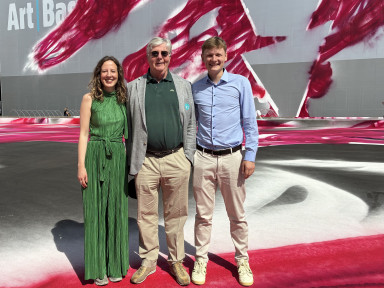

Stephan
Zilkens
,
Zilkens' News Blog 26 2025
This is the 600th edition! For 600 weeks, Stefan Kobel has been writing his weekly press review on the art market. We are delighted and congratulate him on his consistently high-quality work, which enables those interested to catch up on any articles they may have missed. Kobel has all the important ones in German and English.
This is also the 26th news blog of the year – which means that the same number beinig published in the future and the year is almost over – so it's half-time and a moment to look back on the last six months. Fighting continues in Ukraine – only the means employed by Russia are becoming even dirtier (chemical weapons) and more war criminal (against civilians). The new President of the United States is doing his best, in the style of an old, money-hungry white man, to destabilise the world in order to ultimately benefit his own wallet (and that of his family) (Bitcoin, etc.). In Iran, the conflict with Israel has reached a climax, which poses further dangers due to the American bombing of nuclear facilities. If the Strait of Hormuz is now closed, energy prices are likely to rise, as expected. But for how long? It comes as no surprise that the Iranian foreign minister is now flying to Putin – after all, Iran is Russia's largest supplier of drones and part of this unspeakable axis against freedom. The art market and international art exhibitions are also dependent on these parameters. Journeys are becoming longer, more uncertain and more expensive, and it is questionable whether the insurance industry is prepared to maintain the extremely favourable rates for exhibition insurance compared to bank financing.
Is this the right time to enter the art insurance business – as underwriting agents, who are initially expensive partners for insurers in terms of transaction and distribution costs? For insurers who are inexperienced in the business, you deliver a whole lot, including claims settlement. This is called ready-made business at a fixed cost. However, art insurance is considered volatile and therefore more capital-intensive than, for example, normal household insurance. Dr Martin Blumenthal, until recently the North German soul of Allianz's art insurance business, is now working with three other colleagues to launch Gaede&Glauerdt Curated Cover, an underwriting agent for the art business. DUAL, part of the Howden Group, started the same business two years ago with a smaller team. Mund & Fester, which joined Wecoya, the underwriting agent of the GGW Group, and gave up its name, has many years of experience in this niche, dating back to the Anna Amalia fire. The portfolios are not yet large. Liberty, on the other hand, proudly reported at Art Basel that it had built up a portfolio of approximately EUR 85 million in just over nine years in continental Europe alone. That is something that many competitors will find hard to swallow. Is XL, a company of AXA, still number one on the European mainland? In Germany, it is more likely to be Allianz – but you should only believe statistics that you have falsified yourself. Now that companies have stopped filling in association statistics in their entirety, allegedly for antitrust reasons, transparency is a thing of the past.
And then there was Art Basel last week, with over 90,000 visitors and all its satellite fairs, exhibitions and events related to art. It took a while to understand, but there is no other city that goes to such lengths to cater to an international audience and enable them to enjoy art to such an extent as Basel! Paris, Cologne, New York, Miami, Hong Kong – no matter where else art fairs take place – they also take place and there are certainly one or two events or flagged bridges here and there – but does the city live for the fairs? Free admission, free, well-functioning public transport and so on and so forth... only Basel can do that. And that is perhaps an aspect that should be taken into account when talking about a creeping shift of the centre of ART Basel to Paris. More Americans may go there, but the fairs are there too, and not only there!
Incidentally, there was also a wonderful app for Art Basel where you could save your ticket. But AI has arrived: with the help of Microsoft Copilot, the app also selects hotels, restaurants, exhibitions, favourite galleries, artists (of all genders, of course) and who knows what else – all you have to do is buy. However, I found this rather disconcerting, because Copilot is about as good as Google's translation programme – the essence of trade fairs is to discover things for yourself, train your own eye and develop your own quality criteria that you can then use to approach a work of art. AI cannot do that – otherwise I might as well let the trade fairs be and happily buy art online.
Even though the global situation for the second half of the year is difficult to predict, we wish you inspiring days.
The team at Zilkens Fine Art Insurance Broker GmbH in Solothurn and Cologne
automatically translated